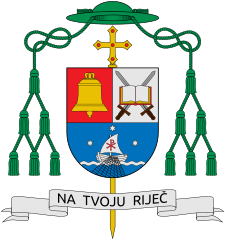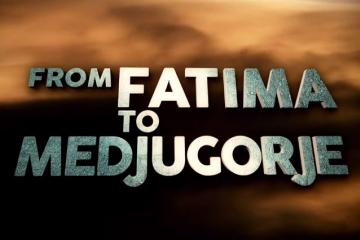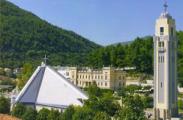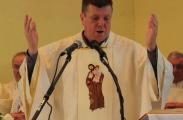The response of Bishop Perić: If General Lieutenant Maksimov is a real person, there should be no problem with organizing a public confrontation. Let all the incriminating documents and their content be shown to the public! Let their authenticity be proved and let everyone, including the Bishop, morally and legally answer for their actions and accept moral and legal responsibility.
Introduction
In the middle of May 2017, a collage film named “From Fatima to Medjugorje” appeared, made by Nazareth Production, script written by a certain Slom Bezael and directed by Ami Drozd. When the promotional announcement, comprised of four trailers, first appeared on the website Dnevno.hr, this Chancery issued a statement in which we refuted all the defamations regarding the shepherds of the Church of Mostar, bishops Pavao Žanić (1918–2000) and Ratko Perić: “Everything said in the film about the supposed ‘cooperation’ of our shepherds Pavao and Ratko with the anti-God and anti-Church secret security, is a blasphemous calumny and has no foundation, nor any involvement with the persons being slandered: it serves only as defamation not just of the individuals but of the Church herself!”
These days we have had the opportunity to see the entire film. We feel the need to intervene once more: not to engage in polemics with the authors—with what truth can malevolent and targeted calumny be refuted?—but for the sake of the truth, and for the sake of the souls of the faithful who may, while watching this defamatory film work, be shaken and agitated, which was obviously the intention of the maker and the publisher.
Thus, we consider this defamatory film work to be disgusting, blasphemous calumny: and what is blasphemous is the work of the father of lies. Therefore, even qualifying the film as calumny is an understatement. The core of which this film was made is nothing new, especially in regard to the alleged ‘cooperation’ of Bishop Žanić, since the ‘cooperation’ of Bishop Žanić with UDBA [translator’s note: Yugoslavian state security administration, commonly known as the Communist secret police] was already addressed in another film work. Also, some of the frames in this latest film, such as the images of the consecration of Bishop Perić in Neum in 1992, are by the same author.
The Film
It would be useless to recount the entire film. We will limit ourselves to the issues involving bishops Žanić and Perić. That is, we will limit ourselves to writing only about the content in which the Mostar bishops are explicitly proclaimed as the ‘collaborators’ of UDBA and the Soviet KGB.
‘Cooperation’ of Bishop Žanić with UDBA
Not only was UDBA concerned with the ‘Medjugorje phenomenon’, but the KGB also, which had been “present in Medjugorje from the beginning”. How were they to effectively suppress something that was destroying the Communist system and Yugoslavia? The position of the local bishop is important. UDBA agent Lasić is in possession of an incriminating document about Bishop Žanić. “It was about an intimate relationship with one of his colleagues when he was really young and of some other details which are not in accord with what he is supposed to represent”. That “document” is handed by KGB agent General Lieutenant Maksimov on 4 October 1981 to Secretary of State Cardinal Agostino Casaroli who is very surprised (as is Vatican diplomat Pietro Sambi and Maksimov himself). The Holy See finds a way to replace the bishop. “At the time of Fr Jozo Zovko’s trials [1981] the Church began to search for Bishop Žanić’s successor. The rector of the Pontifical Croatian College of St. Jerome, Ratko Perić, was invited to an interview. While the UDBA agent Lasić was trying to blackmail Bishop Žanić in Mostar, Ratko Perić declared in Rome that he would accept any duty the Church chose to entrust to him”.
Under the “blackmail” of the sin committed “when he was very young”, Bishop Žanić changes his positive position on Medjugorje and agrees to cooperate with UDBA to disprove “the apparitions” by his apostolic authority: “Among other things, to the satisfaction of the secret service, he dispatched letters to many bishops asking them to stop the flow of pilgrims to Medjugorje. The Yugoslav secret service was happy as the Bishop put into action everything they requested”. So, in order not to be accused, Bishop Žanić cooperates and in return UDBA will not disgrace him. At the same time, the Bishop is reluctant to give up the Mostar diocese, “arguing the thing should not be rushed because he had been assured the incriminating document against him had been destroyed”.
The ‘cooperation’ of rector Perić with the KGB
In December 1982 rector Perić meets KGB agent General Alexander Maksimov, who is the principal and only depicted accuser of the bishops of Mostar: “From then until 1989 we met seven times,” says Maksimov. Although he was inclined to believe in the authenticity of the event in Medjugorje, the rector of St. Jerome promised to the Soviet KGB agent: “If there is some truth in those ‘apparitions’ he would destroy even the least part of it, and that he knew how to do it; [but] they [the KGB] had to act via the Yugoslav UDBA” to “impede the Franciscans in their activities in Herzegovina”, pointing out that “with the Franciscans, it should be done brutally and cleverly, in all ways possible”! His only concern was that the Yugoslav UDBA and Herzegovinian friars should know nothing of his cooperation: “He said he believed us, he knew what a successful service we are, that his Italian colleague who connected us said so too, and that we would arrange everything about coordination with our Yugoslav colleagues, but that no one should ever know he had anything to do with the persecution of the Franciscans. […] He pointed out that one has to be firm with them, that it cannot be done otherwise […]. The agents of the KGB from all parts of the world kept him informed about Medjugorje. They fed him information of what the Franciscans were doing and planning and what bishops around the world were saying, and asked them to influence those bishops to speak out against the phenomenon and discourage the faithful from going to Medjugorje”! “Perić continued to cultivate those contacts and meetings even after the disintegration of the Soviet Union”?!
Film evidence: documents, images, videos
Facsimiles of documents in Russian Cyrillic, which are supposed to corroborate the agent’s claims and be irrefutable evidence, appear seven times in the film. But those facsimiles appear and disappear so quickly that the viewer cannot make out the date of issue or the protocol number, let alone read the names of the participants of the meetings and the content. If you pay attention to the signature on the documents, it is exclusively and only the signature of General Maksimov.
The images and the videos of Bishop Žanić and the rector, later Bishop, Perić are from regular ecclesial and liturgical appearances. It is evident that the images were taken without the permission of the owners, which is, by the way, a felony. But there is no image or evidence of any meeting, conversation or signature by the slandered bishops. There is only one image assembled from pictures of Bishop Žanić and UDBA agent Lasić: Bishop Žanić in his office, Lasić somewhere on the road in his vehicle.
The witness
The main and only witness of this unseen calumny on the bishops of Mostar is a KGB agent, General Lieutenant A. Maksimov. With sunglasses on, looking in one direction, he speaks. He does not look at the camera. We get the impression that he is reading a written text. According to his own statement, he heard of Medjugorje right at the beginning of July 1981 when he was ordered to urgently travel to Belgrade. He has “excellent” contacts in the Vatican. He meets with the Secretary of State and another official in the Vatican itself and in Roman restaurants, such as the Restaurant Columbus. On one occasion, “as a gesture of good will”, he leaves “a personal gift” for the Pope: a list of priests who collaborated with the secret service in Poland, Czechoslovakia, Hungary, Yugoslavia and Ukraine!
We have tried to find out via internet search engines if General Maksimov is a real person. But we could not. We know secret services hide the identity of their agents. But this sort of highly ranked official, a “deputy of the KGB”, cannot easily be hidden. After all, if he is a real person, it should not be a problem to organize a public confrontation with Bishop Perić.
Our response
The ‘cooperation’ of bishop Žanić
The assumption, or more accurately the calumny, that Bishop Žanić was a ‘cooperator’ of the UDBA, as we have already said in the introduction, is nothing new in the media. After that calumny was brought out in the film ‘Gospa’ by Zagreb director Jakov Sedlar, this Chancery responded with a statement on 17 June 1995. When he, in an interview, threatened a lawsuit the Chancery issued a statement again on 1 December the same year, encouraging him in his intent. This Chancery made yet another statement on 21 December 2011 after a book “Misterij Međugorja. 30 godina fenomena” (The Mystery of Medjugorje. 30 years of the phenomenon) had been published by Večernji list in Zagreb, signed by journalists Ž. Ivković, R. Bubalo, Z. Despot and S. Hančić. Some twenty days later, on the anniversary of the death of Bishop Žanić, 11 January 2012, Bishop Ratko refuted these defamations in a homily in the cathedral. And the polemics ceased.
In November 2011, the Bishop made a written request to Mr Almir Džuva, the director of the Intelligence-Security Agency of Bosnia and Herzegovina in Sarajevo, to enable him to view the public records of UDBA reports regarding Bishop Žanić and Medjugorje. The director approved his request and made available copies of more than 30 documents from 1981 until 1988. No document mentions any sort of Communist blackmail or threat, let alone ‘cooperation’. Moreover, in some of the reports which had been sent from the Security service in Mostar to higher ranking officials in Sarajevo, Bishop Žanić declined a meeting with the president of the Commission for religious questions, on 14 July 1981. And as a persistent opponent of the Communist system, Bishop Žanić was referred to as a number one ‘bearer of enemy activity’ in documents dated: 31 January 1983, 7 November 1983, 8 December 1983, 4 January 1984, 7 March 1984 and 24 April 1986. And that kind of ideologically principled opponent of Communism was in Mostar from 1971 until 1993.
However, in this latest film work, at least to our knowledge, a “sin” of Bishop Žanić from “an early age” is brought up. The screenwriter, director and “the witness” do not tell us what “very young” means. Even science does not consider a 20-year-old “very young” or adolescent. Bishop Žanić was born on 20 May 1918. And what a miracle: half a century later UDBA agent Lasić is in possession of an “incriminating document” which makes Bishop Žanić “break under pressure” and “accept” unquestioning cooperation, and makes the Holy See instantly search for his successor: ”At the time of Fr Jozo Zovko’s trials the Church began to search for Bishop Žanić’s successor.” Therefore in 1981. UDBA knows that!
And the truth is that the Holy See, despite supposedly “unquestionable evidence” of “unsuitableness” for the apostolic service, left Bishop Žanić as the head of the Mostar-Duvno and Trebinje-Mrkan dioceses for 12 more years, until 24 July 1993, when he reached the age of 75, which is the canonical age for retirement. Moreover, from 3 November 1988 until 14 January 1990, the Holy See entrusted him with a third diocese, Dubrovnik. Is this how the Holy See relieves from duty bishops who have lived a life, even in youth, “not according to what they should represent”? Does the Holy Father speak in such exalted manner of the sacerdotal and apostolic service as Saint John Paul II did, on the occasion of Bishop Žanić’s 50th anniversary of priesthood and 20th anniversary of his episcopate in 1991, although, according to the makers of the film, Žanić was a disturbance to the Pope himself in his endeavour to destroy Communism, in which Medjugorje was of significant help? “We truly know with what care and zeal you have performed your sacred service during the long path of your life, first as a pastor, then as a diocesan delegate for consecrated women, and lastly as a rector of the minor seminary. Knowledgeable in theology, exceedingly loyal to the Holy See, you diligently sought to spread personal devotion to the Eucharist, with which worship –and you put all of your soul into it- the unity of hearts and minds are guarded. Becoming the coadjutor bishop in 1970, for ten years you invested all your strength for the spiritual good of the faithful of Christ in the Mostar-Duvno diocese, whom you have accompanied with tireless love and brave zeal. And when the diocese was entrusted to your caring administration, the faithful of your flock have already known you as their father and the teacher of divine truths.
We know that troubles and difficulties have made the burden of your pastoral service even more bitter, but you have never lacked fearless faith, moreover, your love towards everyone, exceptional devotion and your diligence in the choice and election of young men called to the service of the Lord have increased entirely. Thus, honourable brother, just bravely forward!”
Doesn’t this say that the authors of this film are defaming the Church herself if the Holy See lauds Bishop Žanić with this kind of treatment, instead of “deserved punishment”? Therefore, we call upon the authors of the film to prove their claim: show it with documents! They are not convincing anyone reasonable with more facsimiles of the “latest documents” which appear in the film at “the speed of light”. If they do not do that, they will be acknowledging themselves as slanderers.
The ‘cooperation’ of the rector and bishop Perić
If it were not a blasphemous calumny which aims to defame the person but the Church herself, the claim that the rector of St. Jerome and Mostar bishop Perić had been a collaborator of the KGB would be a real joke. If we add to that the “motivation”: “He has said he will cooperate, but he made a condition: for us to intervene with Yugoslav secret services to limit the activities of the Herzegovina Franciscans to the maximum”, then we have no words to describe this calumnious construction. Without an image, a document, the Bishop’s signature, the date or place of the meeting, nothing except the agent’s claim: “Yes, I met Ratko Perić in December 1982. From then until 1989 we met seven times”, and thereby declare someone a collaborator of the most infamous intelligence service since the beginning of Communism, can only be done by someone who is filled with hatred towards the person, his ecclesial service and the institution in which the rector and bishop Perić responsibly acted. If we add to that the statement that even after the disintegration of the Soviet Union, and that means after the disintegration of the Communist KGB, while war raged in the Herzegovinian dioceses (a war in whose creation those infamous services had a great role), he maintained contact with them, is complete and utter nonsense. That a Catholic priest, whom “the witness” describes as very intelligent, remained probably the only priest of the Catholic Church who continued to collaborate with the KGB, even after the Berlin wall fell and the Soviet Union disintegrated and the KGB disbanded; that the rector of St. Jerome was informed of events in Medjugorje by “KGB agents”, is ludicrous! We believe that people who think of Bishop Perić as a person not “open” to the Medjugorje phenomenon will also consider this, if not disgusting, then certainly highly unlikely. Unfortunately, not only can anything be printed on paper, but anything can be put on film when the eclipse of the mind and the malice of heart combine.
The only facsimile in the film where the Bishop’s name appears, if it is authentic, says absolutely nothing. In the 31st minute of the film a facsimile of a document appears, which is, as we read: The translation of the protocol received from the Vatican 26 January 1984, Apostolic Palace (Апостольский дворец) Vatican, Holy See. The first two lines highlighted in orange “reveal” the participants of the meeting: Alberto Tricarico, Bishop Pavao Žanić and Ratko Perić. From the next four lines, we can read that the subject of the meeting was “Herzegovina case” and Medjugorje. And nothing more. We say it reveals nothing because it is publicly known, and we have published it a few times, that Bishop Žanić, during his 23 years of service as a bishop, went to Rome more than 80 times and met with the Pope 14 times with the hope that the Holy See would finally and justly resolve the “Herzegovina case” and the “Medjugorje phenomenon”. What is therefore strange and “incriminating” in the fact that his priest serving in Rome accompanied him at those meetings sometimes?
Moreover, Bishop Žanić had meetings every time he came to Rome with Mons. Pierluigi Celata, who was until 1979 desk-officer for events in Yugoslavia, and from 1979 until 1988 that service was performed by Mons. Faustino Sainz Munoz. There was no reason the Bishop would speak with Mons. Alberto Tricarico, who was, from 1982 until 1985, the consultor in the apostolic nunciature of Denmark, Finland, Iceland, Norway and Sweden!
‘Cooperation’ and the situation in the field
If there were any truth in this shameless invention, how could we not ask ourselves: What effects didf the ‘cooperation’ of Perić and Žanić and the pressure from UDBA and the KGB have on the Herzegovinian Franciscans? What was happening to the Franciscans and Medjugorje at that time?
Everyone agrees that the cue for the start of the persecution of the Herzegovina Franciscans Fr Jozo Zovko, Fr Ferdo Vlašić and Fr Jozo Križić, was given by the then-ideologist of the Communist party Branko Mikulić with his speech on “The Day of the Fighter”, 4 July 1981 at Tjentište. After the preparation of the media, on the feast of the Assumption, the arrest followed, then investigative jail in Mostar, the shameful verdict and imprisonment in Foča. What kind of stance the bishop of Mostar had at that time can be found in the film itself, which presents the Bishop’s homily during the Confirmation on 25 July 1981. And at the municipal party conference in Čitluk in August 1981 “the behaviour on the part of the priesthood was vigorously condemned” and the persons cited by name then were Bishop Žanić, Fr Jozo Zovko and Fr Ferdo Vlašić. That Bishop Žanić was not afraid to be named is more that visibly seen in his 1 September 1982 letter of protest to the president of the State Presidency, Sergej Kreigher, where he rejected with indignation the absurd defamations about some of the Franciscans, specifically on Fr Jozo Zovko, as well as himself. He writes: “As the Catholic bishop and the responsible Ordinary of Mostar diocese I reject all the irresponsible defamations and attacks against myself and my priests, the distastefulness of which does not in any way contribute to a sober look on the events in Medjugorje parish. This kind of offensive act offends basic civil and human rights. I appeal to you to accept this protest and, as the most responsible person in the FSRY, take vigorous steps against this kind of irresponsible act.” In the previous part we have already said how UDBA perceived Bishop Žanić.
And the rector of the Pontifical Croatian College of St. Jerome, the priest Ratko Perić? According to “the witness”, their first meeting happened in December 1982 and further meetings continued until 1989. Therefore, rector Perić cannot be involved in the story of the persecution of the Franciscans in 1982, not even according to this film’s construction. Fr Jozo Zovko was arrested, accused, sentenced, deported to the prison in Foča and out of prison already in February 1983; then he came to Herzegovina and took over the parish at Bukovica. At the same time as Fr Jozo Zovko’s trial in November 1981, the separate trial of Fr Ferdo Vlašić and Jozo Križić took place. Fr Ferdo was sentenced to 8 years of prison and Fr Jozo to 5.5 years with the prohibition of public appearance in the press (as an editor and writer) for three years after the completed sentence. After more interventions, the sentence was gradually reduced for Fr Ferdo: 12 March 1982 from 8 to 5.5 years, 15 November 1983 from 5.5 to 5 years and lastly at the beginning of January 1986 from 5 to 4.5 years, which he unfortunately had to do and which had serious consequences (as did previous long-term imprisonment and persecutions): he died age 75, on 15 October 1995. The sentence was reduced from 5.5 to 2.5 years to Fr Jozo Križić. He died age 42, on 9 January 1993. May they both rest in peace!
And Medjugorje? During the incriminating “cooperation” of then priest Ratko Perić with the Soviet intelligence agency the pressure in Medjugorje slowly declined. Instead of imposing prohibitions and obstacles, the Communist police slowly started to regulate the traffic. A logical question can be asked: How come the only demand of Bishop Perić is not being fulfilled and the KGBdid not influence UDBA colleagues in Yugoslavia to increase the persecution of the Franciscans and destroy Medjugorje? Where are the fruits of the “conspiracy pact” to “brutally and cleverly” deal with the Franciscans, “in all ways possible”, even with a “stick” so that “if there is some truth in those ‘apparitions’ even the least part of it should be destroyed”?! And Mons. Perić continued the cooperation even after the disintegration of the Soviet Union and the KGB? Sapienti sat - [To the wise, a word is enough!]
The Film, the ‘cooperation’ and Medjugorje
The film titled “From Fatima to Medjugorje”, deals with the beginnings of the apparitions in Lourdes and Fatima during the first ten minutes, then with the persecution of the seers by representatives both of the Church and civil authorities. Since “politics” was not the main reason behind them, the persecutions stopped, the issue developed and the Church recognized the apparitions. But “politics” is the main reason behind the persecutions in Medjugorje, and in its worst form. With counter intelligence methods the Bishop and his priest at service in Rome, his “possible” and future successor are blackmailed. Both pressured by the blackmailing, they change from being those who “approved of the possibility of the apparitions” to become great critics and work for the destruction of “Medjugorje” with their ecclesial authority in every way possible, and by every means necessary. Is that true?
Bishop Žanić radically changed his stance on Medjugorje after the revelations during his own conversations with the protagonists of the Medjugorje events, and from the findings of the Commissions, the first one and the extended one, which he himself founded, but not under the absurd pressure and invented blackmails of the secret services. As he was a Marian bishop, he believed in the possibility of the apparitions of the Blessed Virgin Mary. He personally led multiple pilgrimages to Marian sanctuaries, especially in Lourdes. And when he in his Catholic conscience and apostolic responsibility came to a conclusion that there are no supernatural revelations in Medjugorje, the Bishop publicly, not secretly and conspiratorially, pointed out his view with arguments in Mostar, as in Medjugorje, Zagreb and Rome. At least that is known! Everyone could agree or disagree with this stance, because it is not a Catholic dogma. But no one has the right to calumniate!
His stance was confirmed by the Croatian bishops and archbishops in their plenary session in Zadar, 10 April 1991, after receiving the report of the Commission they themselves founded. The Declaration clearly stated: “On the basis of studies made so far, it cannot be affirmed that these matters concern supernatural apparitions or revelations”. True, the bishops said that further events must be closely followed and that they would be at the disposal to the faithful that gather in Medjugorje, but official pilgrimages to Medjugorje could not be organized.
Mons. Perić, at the time the film describes, was assigned to pastoral service as the rector of the St. Jerome College in Rome. Therefore, because of distance, and at the time because of limited communication, he was far from everything happening in Medjugorje. Although he was (and “the witness” argues he is capable and educated) known in the Church in Croatia as a theological writer, he never was a part of a commission, not on the diocesan nor the bishops’ conference level. But that he personally followed the events in Medjugorje and examined them from a theological perspective could be expected of him. No reasonable person can blame him for that. That his conclusions were identical to the conclusions of the commissions, of Bishop Žanić and all bishops of the Church in Croatia, cannot be held against him let alone calumniated, because of that. By his consecration as a bishop, becoming first the coadjutor (1992—1993) and then ordinary, he is called to watch over the truth and promote the truth by his own service and by his apostolic responsibility. In that sense, these 25 years of his episcopal service to the Church in Herzegovina we have seen, heard, and read his writings and activities. Therefore, let us ask a rhetorical question: during all these years, can a “blackmailed” person, without fear of being exposed (and fear can in no way be attributed to the Bishop) responsibly and publicly speak about that which by his Catholic conscience and apostolic responsibility he considers to be the truth, despite all the objectors, and run the risk of possibly being exposed?!
The Holy See, which has from the beginning carefully followed all the events in Medjugorje, founded an international Commission only in 2010, by the decision of Pope Benedict XVI and the signature of the Prefect of the Congregation for the Doctrine of Faith. After the end of that Commission’s work, the Congregation itself studiously approached the phenomenon, under its theological and moral aspects. We await the final verdict of the Church. Everyone who is of the truth will let the Church do its work in peace because she is the only one called to state not only a personal opinion and half-truth, but an official stance.
Therefore, we are convinced the film damages Medjugorje itself. For how can we accept that God “blesses” someone’s calumny and malice to reveal the Truth and defend the honour of the Blessed Virgin Mary?!
Conclusion
We said in our first statement already that we will not hesitate, if we find it necessary, to search for legal protection. True, the bishops, who are Jesus’ apostles, are called to be the first to accept, like the Teacher, the contempt of the world: “If the world hates you, realize that it hated me first. If you belonged to the world, the world would love its own: but because you do not belong to the world, and I have chosen you out of the world, the world hates you” (John 15:18-20). After being struck in the high priest’s house, Jesus said:Therefore, once again, we call upon on the authors of this cinematic slander story and all those who have evidence of the collaboration of the pastors of the Church in Herzegovina with the infamous secret services of the Communist regimes: bring forth to the public all incriminating documents and their contents! Prove their authenticity and then let everyone, even the bishop, morally and legally answer for their actions and assume moral and legal responsibility! Whoever then is in possession of any document with the bishop’s file, signature, photo, meeting, tape-recording, video-recording, with any secret intelligence service of this world - let them release this to the light of day!
Everyone who has, sine ira et studio [without anger and fondness], watched this film work will surely realize the emptiness with which it abounds (as long as those who made it do not prove the truthfulness of it: to objective viewers it is a slanderous pamphlet!) To speak in the Christian spirit: we pray they do not reap as they have sown! We pray that we all come to the realization of the Truth and live by the Truth. And woe to those who with even one blasphemous word or action should scandalize even one of the least ones!
Mostar, 26 May 2017
Fr Željko Majić
vicar general




